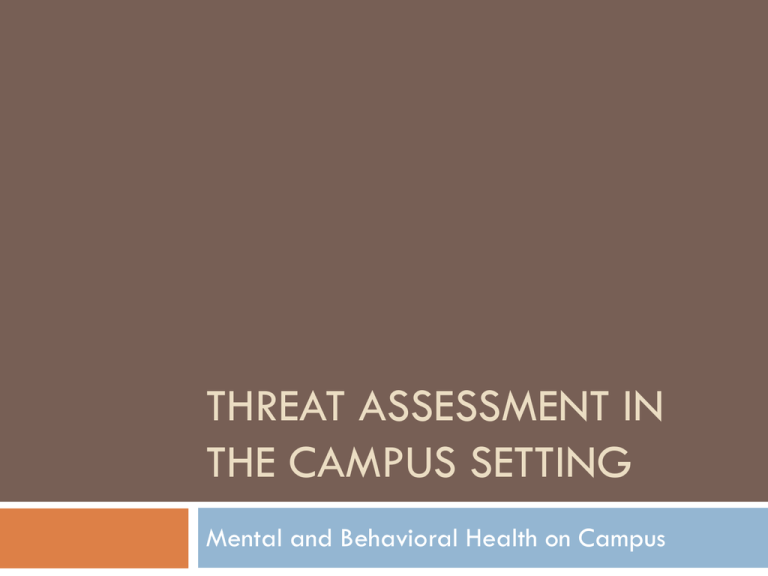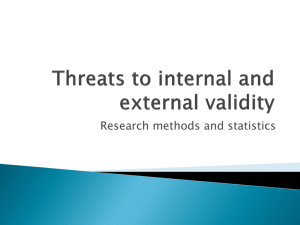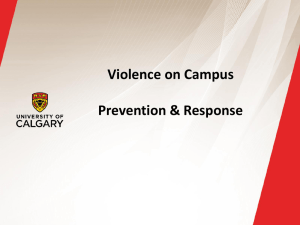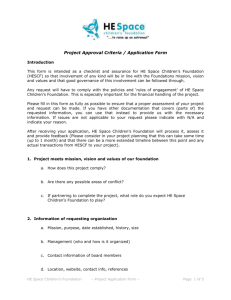THREAT ASSESSMENT IN THE CAMPUS SETTING Mental and Behavioral Health on Campus
advertisement

THREAT ASSESSMENT IN THE CAMPUS SETTING Mental and Behavioral Health on Campus We are attempting to do 3 Things: Threat Assessment Early Intervention …with the Hope of Prevention http://nabita.org/docs/2009NABITAwhitepaper.pd f Going Beyond Our Current Threat Assessment Capacities As a result of campus shootings, other emerging campus violence and the increasing frequency and intensity of mental-illness related issues on campus, colleges and universities have responded by implementing a variety of safety initiatives, including the creation of internal behavior intervention, with the hope of prevention. Three Well-Established Facts 1. Nearly all campus threats come from those who are members of the campus community, or closely related to it. 2. Nearly all campus violence is not spontaneous, but targeted and planned. 3. Nearly all targeted violent actors raise concerns, share their plans, or parts of their plans with others prior to their acts. We often know who is threatening-we’re just trying to figure out how serious their threat is and how serious we should take it. Having said this…we are not saying all campus threats will come from within our community, only that there is a high-likelihood that they will. We are relatively porous and have a high number of visitors to our campus. Measures of Mental Health-Related Risk-The “D” Scale Distress Disturbance Dysregulation Medical Disability Let’s look at these more closely Measures of Mental Health-Related Risk-The “D” Scale: Distress Emotionally troubled (e.g., depressed, manic, unstable. Individuals impacted by actual/perceived situational stressors and traumatic events. Behavior may subside when a stressor is removed or trauma is addressed/processed. May be psychiatrically symptomatic if not coping/adapting to stressors/trauma. Measures of Mental Health-Related Risk-The “D” Scale: Disturbance Increasingly behaviorally disruptive; unusual, and/or bizzarely-acting. May be destructive, apparently harmful or threatening to others. Substance misuse and abuse; self-medication. Measures of Mental Health-Related Risk-The “D” Scale: Dysregulation Suicidal (thoughts, feelings, expressed intentions and ideations). Para-suicidal (extremes of self-injurious behavior, eating disorder, personality disorder). Individuals engaging in risk-taking behaviors (e.g. substance abusing). Hostile, aggressive, relationally abusive. Individuals deficient in skills that regulate emotion, cognition, self, behavior and relationships. Measures of Mental Health-Related Risk-The “D” Scale: Medical disability Profoundly disturbed, detached view of reality. Unable to care for themselves (poor self care/protection/judgement). At risk of grievous injury or death without an intent to self-harm. Often seen in psychotic breaks. 5 Levels of Risk/Mild Risk Disruptive or concerning behavior Student may or may not show signs of distress No threat made or present 5 Levels of Risk/Moderate Risk More involved or repeated disruption-behavior more concerning-likely distressed or low level disturbance. Possible threat made or present. Threat is vague or indirect. Information about threat itself is inconsistent, implausible, or lacks detail. Threat lacks realism. Content of threat suggests threatener is unlikely to carry it out. 5 Levels of Risk/Elavated Risk Seriously disruptive incident(s). Exhibiting clear distress, more likely disturbance. Threat made or present. Threat is vague and indirect, but may be repeated or shared with multiple reporters. Information about threat or threat itself is inconsistent, implausible or lacks detail. Threat lacks realism, or is repeated with variations. Content of threat suggests threatener is unlikely to carry it out. 5 Levels of Risk/Severe Risk Disturbed or advancing to dysregulation. Threat made or present. Threat is vague but direct, or specific but indirect (type of threat vs.object of threat). Likely to be repeated or shared with multiple reporters. Information about threat or threat itself is consistent, plausible or includes increasing detail of a plan (ie., time and place). Threat likely to be repeated with consistency (may try to convince listener they’re serious). Content of threat suggests threatener may carry it out. 5 Levels of Risk/Extreme Risk Student is dysregulated (way off their baseline) or medically disabled. Threat made or present. Threat is concrete (specific and direct). Likely to be repeated or shared with multiple reporters. 5 Levels of Risk/Extreme Risk Information about threat or threat itself is consistent, plausible or includes specific detail of a plan (ie., time, place), often with steps already taken. Threat may be repeated with consistency. Content of threat suggests threatener will carry it out (reference to weapons, means, target). Threatener may appear detached. Measuring Aggression Trigger Phase Escalation Phase Crisis Phase Trigger Phase Hardening: Aggressor becomes more distant and demonstrates a lack of understanding and empathy. Harmful Debate: Aggressor becomes fixated on their own view. May exhibit distrust and obstructionist behavior. No interest in perspective of others. Actions vs. Words: Begins to take action, appears detached/self-absorbed. Acting out in an angry way (punching walls, doors). Escalation Phase Image Destruction: Plants seeds of distrust with intended victim’s community. Forced Loss of Face: Attempts to unmask his victim as an enemy of their own community Threat Strategies: Begins to aggressively respond to perceived threats, begins to articulate their plan, may appear to be on the verge of panic in this phase. Crisis Phase Limited Destructive Blows: Enlists others. Win/Lose Attack: This aggressor may be prepared to give up his life for their cause, but intends to survive. Lose/Lose Attack: This aggressor does not intend to survive and presents with a profound disconnection for his own well-being. Detachment or disassociation results in a calm, methodical execution of his plan. Whole body and behaviors lack animation. Clery ACT The Jeanne Clery Disclosure of Campus Security Policy and Campus Crime Statistics Act, originally referred to as the Campus Security Act. Requires colleges/universities to disclose information about crime on and around their campuses. This legislation is enforced by the United States Department of Education. Clery ACT Schools must publish an annual report disclosing campus security policies and three years worth of selected crime statistics. Schools must make timely warnings to the campus community about crimes that pose an ongoing threat to students and employees. Campus sexual assault victims are assured of certain basic rights. School that fail to comply can be fined by DofE. Conclusion Our key function is to prevent injury and violence. We want to enhance early intervention. Foster thoughtful and timely responses to students in need. Avert tragedy. http://nabita.org/docs/2009NABITAwhitepaper.pd f








